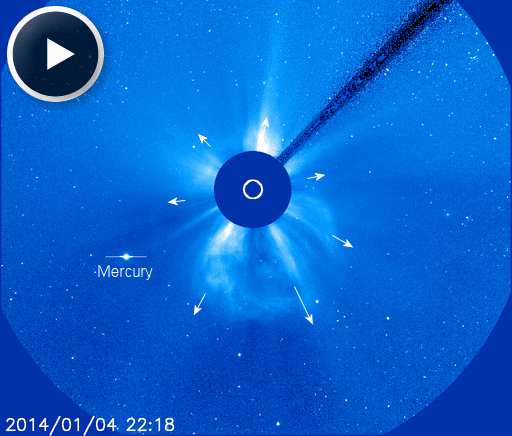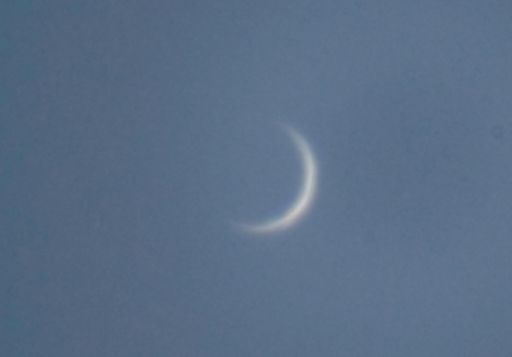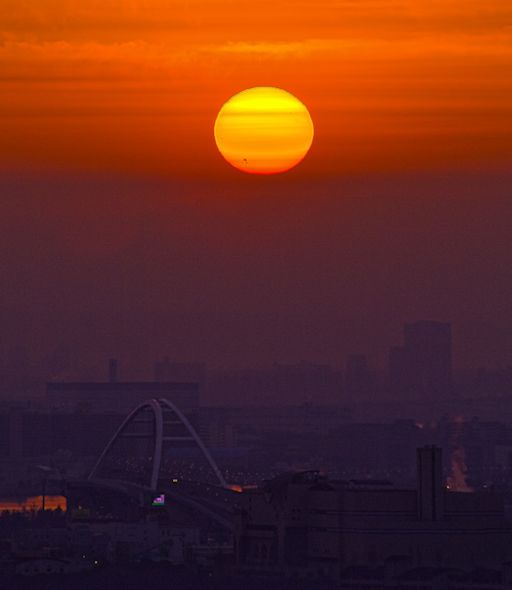FLARES LIKELY TODAY: Giant sunspot AR1944 has developed a 'beta-gamma-delta' magnetic field that harbors energy for potent Earth-directed eruptions. NOAA forecasters estimate a 75% chance of M-class flares and a 30% chance of X-flares on Jan. 5th. Solar flare alerts: text, voice.
CME, POSSIBLY INCOMING: A coronal mass ejection (CME) might be heading for Earth. The cloud blasted away from the sun during the late hours of Jan 4th following a long-duration M4-class solar flare from big sunspot AR1944. SOHO (the Solar and Heliospheric Observatory) recorded the explosion:
The assymetric CME could deliver a glancing blow to Earth's magnetic field on January 7th, possibly sparking G1-class geomagnetic storms. NOAA analysts are still processing the CME imagery for a more precise forecast.
Watch the movie again. There might be two CMEs in there. After the first cloud from sunspot AR1944 emerged, a second cloud was propelled off the sun's western limb by departing sunspot AR1936. The mixture of CMEs complicates analysis of this event. Stay tuned for updates. Geomagnetic storm alerts: text, voice.
Realtime Space Weather Photo Gallery
VENUS, THE CRESCENT PLANET: Venus is turning its night side toward Earth as it approaches inferior solar conjunction on Jan. 11th. Less than 2% of Venus's sunlit hemisphere is now facing us, which means the planet looks like a razor-thin crescent. If you have a GOTO telescope, command it to slew to Venus. It's visible even in broad daylight:
Amateur astronomer Steven Bellavia of New York took the picture at noon on Jan. 4th using a Celestron C5 telescope. "This is the finest crescent Venus I have ever been able to photograph," he says.
Observers who wish to try this for themselves can find Bellavia's photo details here. Be careful, though, because Venus is only 11o from the blinding sun.
GIANT SUNSPOT: Sunspot AR1944, which appeared on January 1st, is one of the largest sunspots of the current solar cycle. It's so big, people are noticing it as a naked-eye blemish on the solar disk. Daisuke Tomiyasu sends this picture from Higashinada-ku, Kobe, Hyogo, Japan:
"Sunspot 1944 was visible at sunrise on January 4th," says Tomiyasu. "I combined three exposures of 1/15sec, 1/100sec, and 1/640sec to create this HDR (high dynamic range) image."
Aside: Look carefully at the full-sized picture. There is a red fringe on the bottom of the sun and a green fringe on top. That's real. The colorful fringes are caused by refraction in Earth's atmosphere. The effect is explained here.
Although the sunspot has been relatively quiet and stable since it first appeared on New Year's Day, a region of this size has the potential to produce significant activity. Indeed, NOAA forecasters, who say they are keeping a close eye on this behemoth, estimate a 75% chance of M-flares and a 30% chance of X-flares on Jan. 5th. Solar flare alerts: text, voice.

Solar wind
speed: 421.9 km/sec
density: 2.4 protons/cm3
explanation | more data
Updated: Today at 1636 UT
X-ray Solar Flares
6-hr max: C6 1518 UT Jan05
24-hr: C6 1518 UT Jan05
explanation | more data
Updated: Today at: 1600 UT
![]()
Daily Sun: 05 Jan 14
Growing sunspot AR1944 has a 'beta-gamma-delta' magnetic field that harbors energy for X-class solar flares. Credit: SDO/HMI
![]()
Sunspot number: 178
What is the sunspot number?
Updated 05 Jan 2014
Spotless Days
Current Stretch: 0 days
2013 total: 0 days (0%)
2012 total: 0 days (0%)
2011 total: 2 days (<1%)
2010 total: 51 days (14%)
2009 total: 260 days (71%)
Since 2004: 821 days
Typical Solar Min: 486 days
Update 05 Jan 2014
The Radio Sun
10.7 cm flux: 182 sfu
explanation | more data
Updated 05 Jan 2014
![]()
Current Auroral Oval:
Switch to: Europe, USA, New Zealand, Antarctica
Credit: NOAA/POES
![]()
Planetary K-index
Now: Kp= 1 quiet
24-hr max: Kp= 2 quiet
explanation | more data
Interplanetary Mag. Field
Btotal: 4.1 nT
Bz: 0.2 nT south
explanation | more data
Updated: Today at 1636 UT
![]()
Coronal Holes: 05 Jan 14
There are no large coronal holes on the Earthside of the sun. Credit: SDO/AIA.







